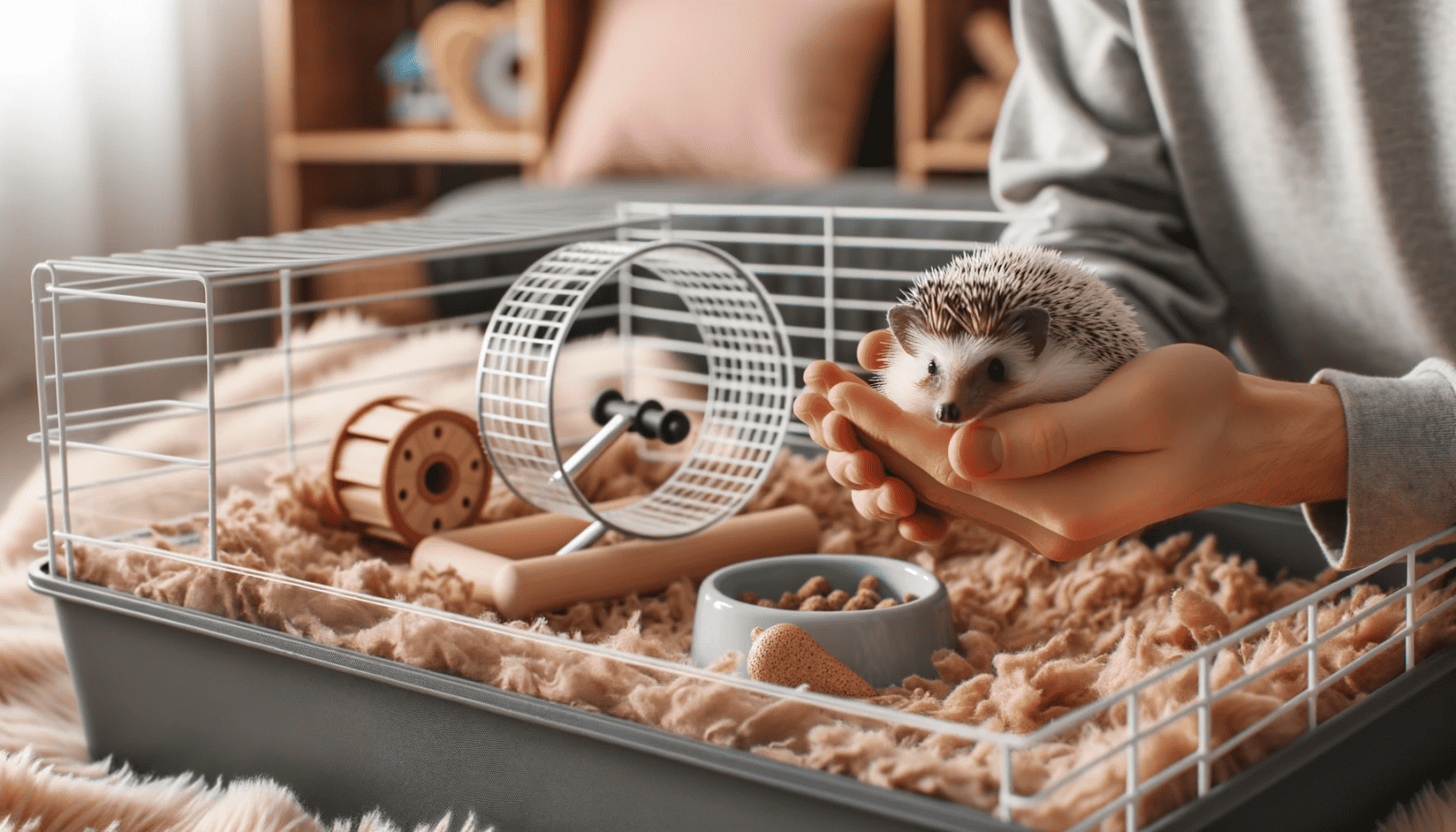Are you ready to embark on the exciting journey of owning a hedgehog?
Did you know that hedgehogs are gaining popularity as pets, with over 1 million households in the United States alone welcoming these spiky little companions?
In this beginner’s guide, you will discover everything you need to know about hedgehog pet care and maintenance.
From choosing the right hedgehog to ensuring a comfortable habitat, feeding, grooming, and keeping them healthy, we’ve got you covered.
Get ready to give your hedgehog a happy and fulfilling life!
Key Takeaways
- Choose a reputable breeder or adopt from a rescue/shelter
- Provide a comfortable habitat with proper temperature and lighting
- Feed a balanced diet and maintain hygiene through grooming and bathing
- Engage in regular exercise and enrichment activities, while understanding hedgehog behavior and health care needs
Choosing the Right Hedgehog
If you’re considering getting a hedgehog as a pet, it’s important to choose the right hedgehog for you. There are a few options when it comes to finding a hedgehog: you can either buy one from a reputable breeder or adopt one from a rescue or shelter.
When looking for a hedgehog breeder, it’s essential to find one that’s reputable and responsible. Look for breeders who prioritize the health and well-being of their hedgehogs. They should be knowledgeable about hedgehog care and genetics, and should be able to provide you with proper documentation and information about the hedgehog’s lineage. A reputable breeder will also allow you to visit their facility and meet the hedgehog’s parents if possible.
On the other hand, adopting a hedgehog from a rescue or shelter is a great option if you’re looking to give a loving home to a hedgehog in need. Many hedgehogs end up in shelters due to various reasons, and adopting them not only gives them a second chance but also helps to reduce the demand for breeding. Before adopting, make sure to inquire about the hedgehog’s health and temperament, and ask for any necessary information and recommendations for their care.
Creating a Comfortable Habitat
When setting up your hedgehog’s habitat, ensure that it’s cozy and inviting by using soft bedding and providing plenty of hiding places. Creating a suitable habitat for your hedgehog involves considering factors such as temperature and lighting, as well as cage size and setup.
Here are some important tips to help you create a comfortable habitat for your hedgehog:
Temperature and Lighting: Hedgehogs prefer a temperature range of 72-80°F (22-27°C). Use a thermostat-controlled heating pad or ceramic heat emitter to maintain a warm and consistent temperature in the habitat. Provide a light source to mimic their natural day-night cycle, using a low-wattage bulb or a small LED light.
Cage Size and Setup: A hedgehog needs a cage that provides enough space for them to move around comfortably. A minimum cage size of 2 feet by 3 feet is recommended. Ensure that the cage has solid sides to prevent drafts and is escape-proof. Add ramps, platforms, and tunnels to create a stimulating environment for your hedgehog to explore.
Bedding and Nesting Materials: Provide your hedgehog with soft bedding such as fleece or paper bedding. Avoid using cedar or pine shavings as they can be harmful to their respiratory system. Additionally, offer nesting materials like shredded paper or fleece strips to allow your hedgehog to create cozy nests for sleeping and hiding.
Feeding Your Hedgehog
To properly nourish your hedgehog, you’ll need to provide a balanced diet that includes both commercial hedgehog food and fresh, high-quality ingredients. Hedgehogs have specific nutritional needs that must be met to ensure their health and well-being. The ideal hedgehog diet consists of a combination of dry food and fresh foods.
Commercial hedgehog food is specially formulated to meet the specific nutritional requirements of hedgehogs. It typically contains a mix of proteins, fats, and carbohydrates, as well as vitamins and minerals. Look for a high-quality commercial hedgehog food that’s specifically designed for hedgehogs to ensure that your pet is getting all the nutrients they need.
In addition to commercial food, it’s important to supplement your hedgehog’s diet with fresh foods. Fresh fruits and vegetables can provide important vitamins and minerals. Some suitable options include apples, carrots, and leafy greens like spinach. Be sure to wash all fresh produce thoroughly and remove any seeds or pits that could be harmful to your hedgehog.
It’s important to remember that hedgehogs are insectivores, so they require a diet that’s high in protein. Insects like mealworms and crickets can be offered as occasional treats or as a supplement to their regular diet. However, it’s essential to ensure that any insects you feed your hedgehog are free from pesticides or other harmful chemicals.
When feeding your hedgehog, it’s important to monitor their weight and adjust their diet accordingly. Hedgehogs can easily become overweight, which can lead to health problems. It’s also crucial to provide fresh water at all times, as hedgehogs can become dehydrated easily.
Hygiene and Grooming
To maintain your hedgehog’s hygiene and grooming, regularly brush their quills and trim their nails. Proper hygiene is essential to keep your hedgehog healthy and happy.
Here are some tips to help you with hedgehog bathing and nail trimming:
Hedgehog bathing: Hedgehogs are generally clean animals and don’t require frequent baths. However, if your hedgehog gets dirty or smelly, you can give them a bath. Fill a shallow basin with warm water, making sure it isn’t too deep for your hedgehog to stand comfortably. Gently place your hedgehog in the water and use a mild, unscented shampoo made specifically for small animals. Gently massage their quills and body, avoiding the face and ears. Rinse thoroughly and dry your hedgehog with a soft towel or a low heat blow dryer.
Nail trimming: Hedgehogs have sharp nails that can cause scratches or discomfort. Regular nail trimming is necessary to prevent injury. Use small animal nail clippers or human nail clippers with a straight edge. Hold your hedgehog’s paw firmly but gently, and trim the tip of each nail, being careful not to cut too close to the quick. If you’re unsure about how much to trim, it’s best to seek advice from a veterinarian or a professional groomer.
Exercise and Enrichment
To ensure your hedgehog stays healthy and active, make sure you regularly provide exercise and enrichment opportunities. Hedgehogs are naturally active animals and need regular exercise to maintain their physical and mental well-being. One way to provide exercise is through the use of hedgehog exercise equipment. There are various options available, such as hedgehog wheels or tunnels, which allow your hedgehog to run and explore in a safe and controlled environment. These exercise tools are essential for promoting physical activity and preventing obesity in hedgehogs.
In addition to exercise equipment, hedgehog toys also play a crucial role in keeping your pet engaged and stimulated. Invest in toys that are specifically designed for hedgehogs, such as puzzle feeders or interactive toys. These toys provide mental stimulation and help prevent boredom. You can also create a playtime routine with your hedgehog, allowing them to explore a safe and supervised area outside of their enclosure. This helps promote socialization and gives them an opportunity to explore their surroundings.
Remember to always supervise your hedgehog during playtime and provide a variety of toys to keep them interested. Regular exercise and enrichment not only keep your hedgehog physically fit but also contribute to their overall happiness and well-being. By providing the right equipment and toys, you can ensure that your hedgehog leads a healthy and fulfilling life.
Understanding Hedgehog Behavior
Have you ever wondered why hedgehogs exhibit certain behaviors, and how you can understand and respond to them as a pet owner? Understanding hedgehog behavior is crucial in providing the best care for your hedgehog and ensuring their well-being. Here are some key points to help you comprehend their communication and recognize signs of stress:
Understanding hedgehog communication: Hedgehogs communicate through a variety of ways, including body language and vocalizations. They may puff up their quills, tuck their head, or hiss when they feel threatened or scared. Pay attention to their body language and vocal cues to better understand their emotions and respond accordingly.
Recognizing signs of stress in hedgehogs: Hedgehogs can experience stress due to various factors such as loud noises, sudden changes in their environment, or being handled too roughly. Signs of stress include excessive quill loss, decreased appetite, excessive sleeping, and aggressive behavior. If you notice any of these signs, it’s essential to provide a calm and secure environment for your hedgehog and consult with a veterinarian if necessary.
Understanding hedgehog behavior is an ongoing process, and each hedgehog may have unique behaviors and preferences. By observing their communication cues and being attentive to signs of stress, you can ensure a happy and healthy life for your hedgehog companion.
Handling and Bonding With Your Hedgehog
To develop a strong bond with your hedgehog, it’s important to handle them gently and regularly. Handling your hedgehog regularly will help them become more comfortable with you and build trust over time. When picking up your hedgehog, it’s important to support their body and avoid squeezing them. Instead, use your hands to scoop them up from the sides and cradle them gently. Avoid handling your hedgehog when they’re sleeping or eating, as this can startle them and lead to defensive behavior.
In addition to regular handling, there are various bonding techniques and socialization tips that can help strengthen the bond between you and your hedgehog. One technique is called ‘lap time,’ where you place your hedgehog on your lap and let them explore and interact with you in a safe and controlled environment. This can help them get used to your scent and presence.
Another technique is to offer your hedgehog treats and rewards during handling sessions. This positive reinforcement can help them associate handling with positive experiences and create a stronger bond. Additionally, talking to your hedgehog in a calm and soothing voice can help them feel more at ease and comfortable.
Health and Veterinary Care
Regular veterinary check-ups are essential for maintaining the health of your hedgehog. Just like any other pet, hedgehogs need proper medical care to ensure they live a long and healthy life. Here are some important things to consider when it comes to the health and veterinary care of your hedgehog:
Find a knowledgeable and experienced exotic animal veterinarian: Hedgehogs have unique needs and require specialized care. It’s crucial to find a veterinarian who’s familiar with hedgehogs and has experience treating them.
Budget for veterinary expenses: Veterinary care can be expensive, especially for exotic pets like hedgehogs. It’s important to budget for regular check-ups, vaccinations, and any unexpected medical issues that may arise.
Consider health insurance coverage: Some pet insurance companies offer coverage for exotic pets, including hedgehogs. Health insurance can help offset the cost of veterinary care and provide peace of mind knowing that your hedgehog’s health needs are covered.
Common Hedgehog Health Issues
When caring for a hedgehog, it’s important to be aware of common health issues that may affect your pet. By understanding these issues, you can take proactive steps to keep your hedgehog healthy and happy.
One common health issue that hedgehogs may experience is obesity. This can occur if they’re overfed or not given enough exercise. To prevent obesity, it’s important to provide a balanced and appropriate diet for your hedgehog. A diet consisting of high-quality cat food, supplemented with insects, fruits, and vegetables, can help maintain a healthy weight.
Another health issue is mites and fleas, which can cause discomfort and skin irritation. Regularly checking your hedgehog for any signs of these pests and providing appropriate treatment can help prevent infestation.
Additionally, proper hedgehog handling techniques are crucial for their well-being. Hedgehogs have sensitive spines that can easily break or become damaged if mishandled. Always approach your hedgehog gently and support their body with your hands.
Preventing and Treating Parasites
Check your hedgehog regularly for signs of parasites, such as itching or hair loss, and promptly treat any infestations to ensure their well-being. Parasites can cause discomfort and health issues for your hedgehog, so it’s important to take preventive measures and know how to properly treat them if they occur.
Here are some tips to help you prevent parasites in your hedgehog and identify symptoms for prompt treatment:
Maintain a clean living environment: Regularly clean your hedgehog’s cage and bedding to minimize the risk of parasites. Remove any soiled bedding and sanitize the cage to prevent infestations.
Practice good hygiene: Wash your hands before and after handling your hedgehog, as some parasites can be transferred from you to your pet. Additionally, avoid allowing your hedgehog to come into contact with other animals or their droppings, which can carry parasites.
Monitor your hedgehog’s health: Keep an eye out for any signs of parasites, such as excessive scratching, hair loss, or skin irritations. If you notice any of these symptoms, consult a veterinarian for proper diagnosis and treatment.
If your hedgehog does develop a parasite infestation, it’s important to seek proper treatment. Your veterinarian may prescribe specific medications or recommend topical treatments to eliminate the parasites. Follow their instructions carefully and continue any recommended treatments until the infestation is completely eradicated.
Hedgehog Safety and Household Hazards
Make sure to keep your hedgehog safe by being aware of potential household hazards. Hedgehog proofing your home is essential to ensure the well-being of your pet. Start by securing any loose cords or wires that could pose a risk of entanglement. Hedgehogs are curious creatures and may chew on electrical cords, leading to dangerous electric shocks.
It’s also important to keep your hedgehog away from toxic plants, such as lilies, azaleas, and ivy, as they can be harmful if ingested.
Additionally, be cautious with cleaning products and chemicals. Hedgehogs have sensitive respiratory systems, so avoid using strong chemicals or aerosols near their habitat. Ensure that any cleaning products or detergents are stored securely out of your hedgehog’s reach.
Furthermore, be mindful of potential household toxins. Some common household items, such as certain foods, medications, and cleaning agents, can be toxic to hedgehogs. Chocolate, caffeine, alcohol, and certain fruits and vegetables should be avoided. Always consult with your veterinarian for a complete list of hazardous substances.
Frequently Asked Questions
How Long Do Hedgehogs Typically Live?
Hedgehogs typically live for around 4-6 years. However, it’s important to note that some hedgehogs can live longer with proper care. Common health issues include obesity, dental problems, and respiratory infections.
Can Hedgehogs Be Litter Trained?
Hedgehogs can be litter trained, which can be beneficial for both you and your pet. Follow these hedgehog litter training tips to ensure success and enjoy a cleaner living space.
Are Hedgehogs Noisy Pets?
Hedgehogs can be noisy pets, especially at night. They are nocturnal creatures and may make scratching or digging noises in their cages. Additionally, they may snore or make clicking sounds. It’s important to be aware of these behaviors. Common health issues in hedgehogs include mites, respiratory infections, and obesity. Regular vet check-ups and proper care can help prevent these issues.
What Kind of Toys Do Hedgehogs Enjoy Playing With?
Hedgehogs enjoy a variety of toys for both interactive and solo play. Some popular options include tunnels, puzzle feeders, and textured balls. You can also make DIY toys using safe materials like fleece or cardboard.
How Often Do Hedgehogs Need to Be Taken to the Vet for Check-Ups?
How often do you need to take your hedgehog to the vet for check-ups? Regular vet visits are crucial to monitor their health, ensure proper diet and nutrition, and prevent common health issues.
Conclusion
Now that you have learned the essentials of hedgehog pet care and maintenance, you’re ready to provide a happy and healthy life for your prickly companion.
By choosing the right hedgehog, creating a comfortable habitat, providing proper nutrition, practicing good hygiene, offering exercise and enrichment, and ensuring regular veterinary care, you can prevent common health issues and keep your hedgehog safe.
Remember to always be aware of potential household hazards and enjoy the unique and rewarding experience of being a hedgehog owner.
















Leave a Reply
View Comments